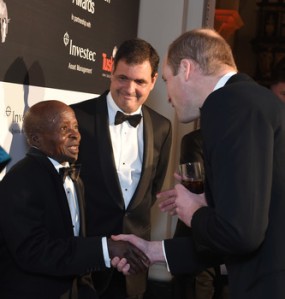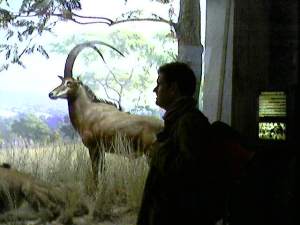Giant Sable Shepherd given prestigious Tusk Ranger Award
Last week, Pedro Vaz Pinto, the Angolan biologist behind giant sable conservation in Angola, brought Manuel Sacaia to London to receive the Tusk Ranger Award at an event presided over by the Duke of Cambridge and David Attenborough. Sacaia, the elder member of a team of “sable shepherds” who now guard the country’s endangered antelope, has been shot at by poachers and had his leg caught in a mantrap, but continues his work undeterred. He was born on the border of the Luando Reserve, the historic habitat of the animal, and has spent decades looking after the palanca negra gigante. This short YouTube video captures his modesty and his passion for conservation.
Will Secret Wildlife Imports Doom Ultra-Rare Giant Sable?
credit: Richard Estes
My report on the latest threat to the critically endangered giant sable antelope of Angola is now online at National Geographic News.
Giant Sable Genetic Research Critical to its Conservation
I had the privilege of traveling with Angolan biologist Pedro Vaz Pinto last week as he visited natural history museums from Washington, DC to Cambridge, Massachusetts. Stops included the Smithsonian, the American Museum of Natural History, Yale Peabody, and Harvard’s Museum of Comparative Zoology. His mission? To obtain snippets of skin and tissue from ultra-scarce specimens of Hippotragus niger variani, the giant sable antelope of Angola.
Handsome and sleek as show ponies, the common sable subspecies seen in Botswana, Zambia, and South Africa makes visitors on game-viewing safaris reach for their cameras. But they pale in comparison to the majestic giant sable, found only in Angola, and an icon there. The coal-black males, which carry scimitar-shaped horns over five feet in length, are featured on the country’s currency and the tailfins of its airline. Even the national soccer team is named after the antelopes—which also happen to be one of Africa’s most endangered mammals.
Vaz Pinto estimates that only a hundred of these walking emblems remain.
On a daringly ambitious 2009 expedition into the remote Luando Reserve, Vaz Pinto managed to pull off a conservation coup and locate the remnants of a population long feared a casualty of Angola’s 27-year-long civil war. He went on to dart and relocate a giant sable bull and nine females to start a captive breeding program in nearby Cangandala National Park. (Read my two-part Africa Geographic article on the expedition, “Antelope From the Ashes”– click here for Part I and Part II). So far, the protected herd there, bolstered in number by subsequent translocations, has produced five calves this year.
But Vaz Pinto is all too aware that field work, not matter how impressive, isn’t enough to ensure the giant sable’s future. He’s in a race against time, against bush-meat poaching, against inadequate resources for the nation’s parks and reserves. For the past decade, he’s cajoled officials and the military for support, and local oil companies, like Exxon-Mobil, for funds.
Now he needs more attention from the zoological community. In the past, the taxonomic status of Angola’s legendary antelope was clouded by doubts that it was anything more than a large local variant of the unendangered common sable.
Recent DNA research has confirmed the giant sable’s subspecies status, but Vaz Pinto wants to go a step further. He’s doing doctoral research in the CIBIO lab at Oporto University, Portugal. “We expect to sequence the entire giant sable genome next year,” he says. Such detailed genetic information would provide critical help in guiding the captive breeding program currently underway. And it also would underscore the giant sable’s stature, hopefully spurring an international push for the conservation it desperately needs.
Vaz Pinto needs samples of historic giant sable material he can analyze. But requests for even tiny snips of skin aren’t treated lightly by museums. It amounts to destructive sampling of a limited supply of specimens. Fortunately, the conservation implications of his ground-breaking laboratory research seem to be overcoming institutional scruples. So far, he’s receiving strong encouragement for his next achievement on behalf of Angola’s national animal.
A Certain Curve of Horn reissued in revised and updated e-book edition
A revised and updated e-book edition of A Certain Curve of Horn: The Hundred-Year Quest for the Giant Sable Antelope of Angola issued by Grove Press is now available:
“In A Certain Curve of Horn, John Frederick Walker tells the story of one of the most revered and endangered of the regal beasts of Africa: the giant sable antelope of Angola, a majestic, coal-black quadruped with breathtaking curved horns over five feet long.
As he follows the trail of this mysterious animal, Walker interweaves the stories of the adventurers, scientists, and warriors who have come under the thrall of the beast, and how their actions would would shape the fate of the giant sable antelope and the history of the war-torn nation that is its only home.
First published in 2002, Walker’s account of his quest for Angola’s legendary animal was called ‘riveting,’ ‘fascinating,’ and ‘compelling’ by reviewers, who compared it to Peter Matthiessen’s classic, The Snow Leopard.
Walker joined the first post-war expedition that found evidence that the iconic creature had survived the country’s horrific 27-year-long civil war, but years passed before it could be photographed—and discovered to be on the brink of extinction. Now Walker brings the story full circle, taking the reader on a last-chance expedition to find Africa’s most magnificent antelope and the heart-pounding conservation triumph of its rescue.”
JFW at the Beardsley Zoo
I’ll be lecturing on current giant sable antelope conservation efforts at Connecticut’s Beardsley Zoo in Bridgeport on Wednesday, April 20, 2011 from 7 to 9 pm. (Click here for directions):
“African Adventures – The Return of the Giant Sable Antelope
John Frederick Walker shares his search for Angola’s legendary giant sable antelope. Hear about the struggles and successes of bringing this beautiful animal back from the brink of extinction. There is a $5 suggested donation. Refreshments will be served. This lecture, taking place in the Hanson Exploration Station, is part of the Evening Lecture Series, sponsored by Connecticut’s Beardsley Zoo Volunteer Association.”
JFW Giant Sable antelope lecture at the Explorers Club
On January 10, 2011, I’ll be giving a presentation at the Explorers Club on the dramatic rescue of the critically endangered giant sable antelope of Angola. I’ll be showing photographs I took from the expedition that succeeded in pulling this legendary creature back from the brink of oblivion—a conservation triumph.
Time: 6:00 pm
Place: The Explorers Club, 46 East 70th Street, New York NY
The event is open to the public. Full details here.
Angola’s Giant Sable Makes a Triumphant Comeback
The latest issue of SWARA, the quarterly journal of the East African Wild Life Society, includes my latest piece on the rescue of the giant sable antelope, the national animal of Angola. You can read the article here: GiantSable.Swara.







1 comment